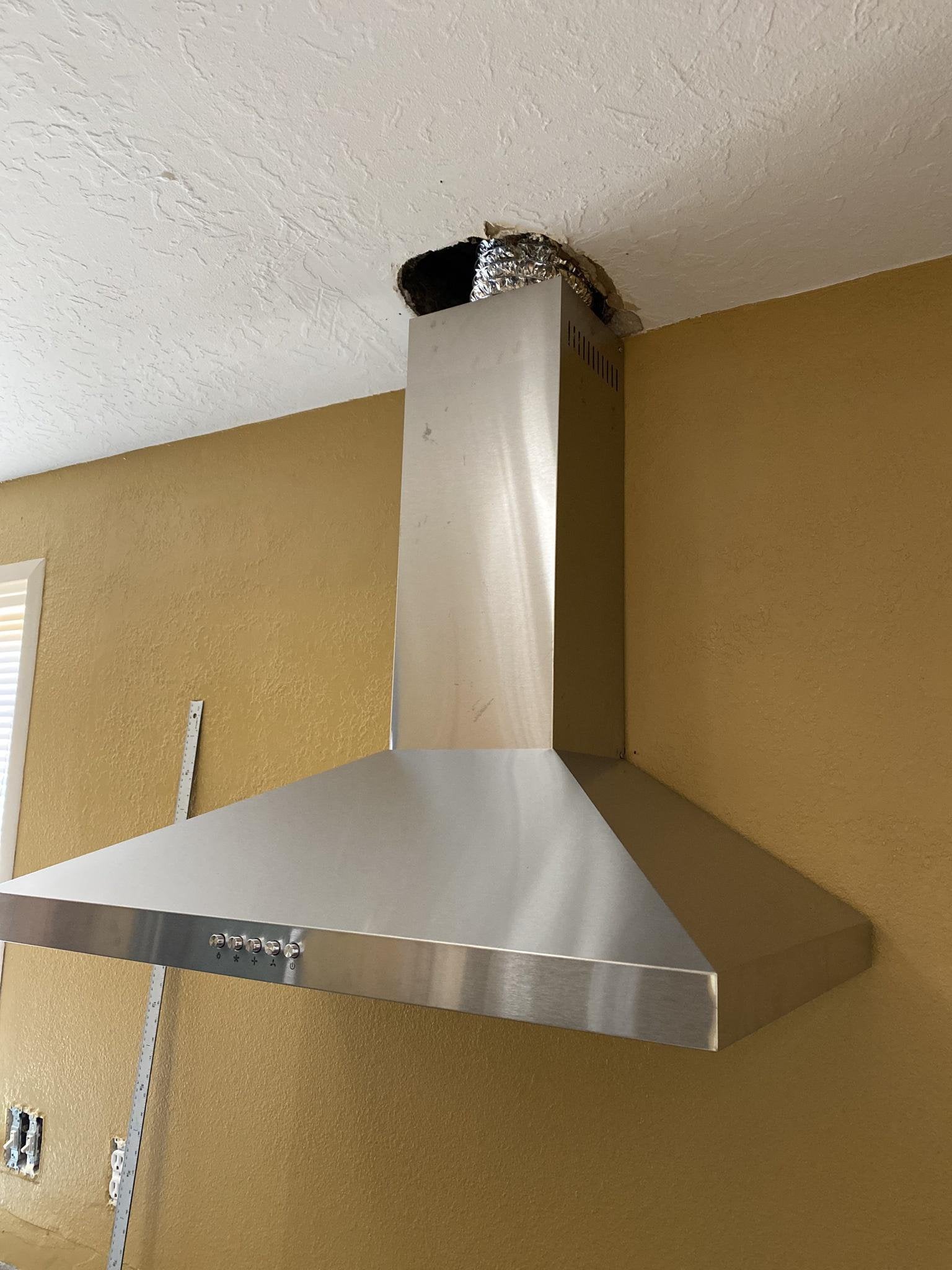If you’re lucky enough to have a slanted ceiling in your kitchen, you can take advantage of that extra space by installing a range hood. Range hoods come in all shapes and sizes, so you’ll need to measure your kitchen carefully before purchasing one. Installation is fairly straightforward, but there are a few things you’ll need to keep in mind if you have a slanted ceiling.
In this blog post, we’ll walk you through the process of installing a range hood on a slanted ceiling.
- Measure the distance between the top of your range and the ceiling
- Cut two pieces of 2×4 lumber to this measurement
- Place these pieces on either side of your range, flush with the back edge of the stovetop
- Screw them into the wall studs to secure them in place
- Place a third piece of 2×4 across the first two, perpendicular to them
- This will act as a support beam for your range hood
- Screw this piece into the wall studs as well, making sure it is level before tightening all the way
- 7a) If you are installing a vented range hood: Cut a hole in your ceiling where the front edge of your support beam is located, using a drywall saw or hole saw attachment on a power drill
Columbia Business School D2LED Sloped Ceiling Installation
Can You Put a Range Hood in a Vaulted Ceiling?
Most often, homeowners with a vaulted ceiling choose to forgo a range hood altogether. The main reason for this is that range hoods are designed to be installed flush with the bottom of the cabinets. When you have a vaulted ceiling, the bottom of your cabinets is likely much higher than where a traditional range hood would be installed.
Not only is it difficult to find a range hood that will fit properly in this type of installation, but it can also be quite expensive.
Another option is to install a recessed or “can” style range hood. This type of range hood sits inside the cabinet and only the front portion protrudes out.
This allows you to still get adequate ventilation without having to worry about clearance issues with your vaulted ceiling. However, keep in mind that these types of range hoods can be more difficult to clean since they’re not as easily accessible as traditional models.
Should Range Hood Be at Eye Level?
Eye level range hoods are not only more attractive and stylish, but they are also more functional. By having the range hood at eye level, you can better see what you are cooking and avoid any potential hazards. In addition, when fumes and smoke rise from the stovetop, they will be immediately drawn up into the range hood, making your kitchen a safer and healthier place to be.
Should Range Hoods Go to the Ceiling?
There is no right or wrong answer to this question, as it depends on personal preference and the overall design of your kitchen. That said, there are a few things to keep in mind if you are considering installing a range hood that reaches to the ceiling.
One advantage of having a taller range hood is that it can effectively remove smoke and odors from the air, since they will rise up and be drawn into the hood.
This is especially beneficial if you do a lot of cooking with strong-smelling ingredients.
Another consideration is aesthetics: a taller range hood can make a kitchen look more spacious and open, while also providing an opportunity to add some visual interest with an ornate or unusual design.
On the downside, taller range hoods can be more expensive and difficult to install than shorter ones.
They also require more maintenance, as they need to be cleaned more often to prevent grease and grime buildup.
How Do You Mount a Range Hood on a Ceiling?
Most homes have a range hood mounted above the stove or cooktop in the kitchen. Range hoods come in all shapes and sizes, but most are either square or rectangular. Some range hoods are vented to the outside of the home, while others recirculate the air back into the kitchen.
If you’re planning to install a range hood in your kitchen, there are a few things you need to take into consideration. The first is what type of material you want your range hood to be made out of. Range hoods can be made out of stainless steel, copper, or even wood.
The second thing to consider is how powerful you want your range hood to be. Most range hoods come with variable speed settings so that you can adjust it to meet your needs.
When it comes time to actually mount your range hood, there are two main ways to do it.
The first is by mounting it directly onto the ceiling using screws and brackets. The second way is by suspending it from the ceiling using chains or ropes. If you’re unsure about which method would work best for your kitchen, consult with a professional before making any final decisions.


Credit: www.youtube.com
Best Range Hood for Vaulted Ceiling
If you have a vaulted ceiling in your kitchen, finding the best range hood for that space can be a challenge. There are a few things to consider when choosing a range hood for a vaulted ceiling, and we’ve got some tips to help you make the best choice.
The first thing you need to consider is the height of your range hood.
Vaulted ceilings can vary greatly in height, so it’s important to measure from the top of your stove to the highest point of the ceiling before you start shopping. You want to make sure that your range hood will be tall enough to effectively ventilate your kitchen.
Another important consideration is the shape of your range hood.
Most range hoods are designed for use with rectangular stoves, but if you have a round or oval-shaped stove, you may need to look for a speciality range hood. The shape of your stove will also dictate how many vents you need in your range hood – more vents means better ventilation but also more noise.
Finally, think about what kind of ventilation system you want in your rangehood.
The most common type is ducted ventilation, which sends all of the smoke and fumes outside through an external vent. This is the most effective way to ventilate your kitchen, but it does require some extra installation work. If you don’t want to go through the hassle of installing ductwork, look for a rangehood with recirculating ventilation.
These types of hoods clean the air inside your kitchen using filters, so they don’t need an external vent. Keep in mind that recirculating rangehoods aren’t as effective at removing smoke and fumes as ducted models, so they’re not ideal if you do a lot of cooking that creates lots of smoke and smells.
Should Range Hood Go to Ceiling
If you’re wondering whether your range hood should go to the ceiling or not, there are a few things to consider. First, think about the overall style of your kitchen. If you have a sleek and modern kitchen, a ceiling-mounted range hood can help complete the look.
On the other hand, if your kitchen has more of a rustic or traditional feel, a wall-mounted range hood may be a better option.
Another factor to keep in mind is practicality. A ceiling-mounted range hood can be great for keeping smoke and smells out of your kitchen, but it can also be difficult to clean.
Wall-mounted range hoods are easier to reach and clean, so they may be a better choice if you do a lot of cooking at home.
Ultimately, the decision of whether to install a ceiling-mounted or wall-mounted range hood is up to you. Consider your kitchen’s style and your own needs when making your decision.
Low Profile Island Range Hood
If you’re looking for a range hood that won’t obstruct your view of the beautiful island in your kitchen, then a low profile island range hood is perfect for you. These range hoods are designed to be installed as close to the ceiling as possible, so they don’t stick out and get in the way. Low profile island range hoods come in a variety of styles and finishes to match your kitchen’s décor, and they’re available in both ducted and ductless models.
Ducted models are connected to an external venting system that removes smoke and odors from the air, while ductless models simply recirculate filtered air back into the kitchen. Both types of range hoods offer effective ventilation, so it’s really a matter of personal preference which one you choose.
Installation is easy with a low profile island range hood, especially if you go with a ductless model.
Simply hang the unit from the provided mounting brackets and plug it into an outlet – no messy ductwork required! Whether you choose a ducted or ductless model, you’ll enjoy years of trouble-free performance from your new low profile island range hood.
Conclusion
If you’re looking to install a range hood on a slanted ceiling, there are a few things you’ll need to keep in mind. First, you’ll need to make sure that the range hood is compatible with the slope of your ceiling. Second, you’ll need to secure the range hood properly so that it doesn’t come loose.
And finally, you’ll want to be aware of any potential ventilation issues that could arise from installing a range hood on a slanted ceiling. With these tips in mind, installing a range hood on a slanted ceiling should be a breeze!

